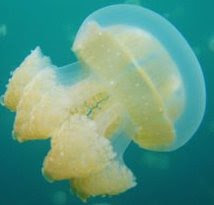
Yesterday and today I'm hanging out with some people who care abut science education. We've had some wonderful conversations. I'm pleased to lean that there are some very smart people who think there's something seriously wrong with the way modern science is progressing. I was delighted to learn that there are a growing number of scientists who think the peer review system is broken. A lot of junk is being published.
Speaking of junk, there's an essay in this week's
Nature that qualifies in more ways than one [
Rise of the Digital Machine]. Mark Pagel is a biologist at Reading University (UK). He's one of those people who just can't accept the fact that humans don't have several times more genes than an insect or a nematode.
THEME
Genomes & Junk DNA
Humans are almost unimaginably complex, with trillions of cells organized into hundreds of different tissues. But we have scarcely more genes than a fruitfly or a worm, and only about four or five times as many as brewers' yeast or some bacteria. Surprising then that the human genome is 250 times larger than the yeast's. It comprises about 99% 'junk DNA' — genetic code that is not used to make the protein building blocks of life.
You know what's coming next, don't you? We're going to hear about one of the seven silly excuses for why we don't really have junk DNA (see
The Deflated Ego Problem). Here's how Martin Pagel sets up his choice of excuse.
Junk DNA gives every appearance of fulfilling the metaphor of the selfish gene. It accumulates in organisms' genomes simply because it is good at accumulating; it can even be harmful. Why we put up with it has long been a mystery.
Increasingly, it seems that the genes that do code for proteins may recruit some or all of this junk DNA to regulate when, where and how much they are expressed. Because nearly every cell in the body carries a complete copy of the genome, something has to tell the genes that make eyes not to switch on in the back of the head, or genes for teeth to stay silent in our toes. Something has to instruct genes to team up to produce complex structures such as hearts and kidneys, or the chemical networks that create our metabolism and physiology.
Astute readers will see where this is going—he's going to use the "regulatory DNA" excuse. All this will accomplish is to demonstrate; (a) Martin Pagel's inability to reason like a scientist by considering evidence that has been accumulated over four decades, and (b)
Nature's inability to recognize good science from bad science.
Genes, in effect, use regulation to promote their interests within the bodily phenotype: it is how they vary their exposure to the outside world. Regulation is how we can have over 98.5% similarity to chimpanzees in the sequences of our coding genes, yet differ so utterly from them.
Indeed, the huge quantity of junk DNA in the genomes of most complex organisms may act as a vast digital regulatory mechanism. Until recently many common machines, such as aeroplanes, clocks, and even computers were analogue devices, regulated by levers, springs, heat or pressure. Aeroplanes were flown with a stick, springs drove clocks. Digital regulation — instructions encoded in strings of binary numbers arbitrarily long, and hence precise — enabled complexity to increase. Stealth fighters and space shuttles are so complex that they can be flown only by digital computers, not (analogue) human pilots.
Similarly, the emergence of digital regulation derived from unused stretches of junk DNA may have precipitated the transition from single cells to complex multicellular organisms. Long runs of the four chemical bases that make up DNA can easily act like binary strings. How these stretches bind to a gene can regulate exquisitely the degree and timing of that gene's expression. Tellingly, bacteria and some other single-celled organisms have negligible amounts of junk DNA. They rely far more on analogue systems of gene regulation that are protein-based and less precise.
This is, of course, complete nonsense. We know for a fact that large amounts of the human genome are really junk. We know for a fact that you can have complex regulation by using only a small percentage of the genome (1000 bp
per gene, or less than 1% of the genome, per gene is more than sufficent [
Junk in Your Genome: Protein-Encoding Genes]. We know for a fact that some single-celled species (amoeba) have huge amounts of junk DNA and some some complex multicellular species have genomes that are much smaller than mammalian genomes (
Drosohila melanogaster.
All these facts can be found in basic introductory textbooks. In addition, there is an abundant scientific literature on junk DNA, explaining why defective transposons (for example) really are junk. Why can't scientists like Mark Pagel, and the
Nature reviewers, learn about junk DNA beore spouting off? What's wrong with science today?
Science is a process and that process involves collecting evidence and making hypotheses that explain the data. In this case the author has ignored the data showing that much of our genome is junk. He has ignored the evidence that the regulation of gene expression can be easily accomplished without invoking huge amounts of (non-conserved) DNA. He has constructed an hypothesis to explain something that doesn't need explaining; namely, why humans have the same number of genes as other mammals. He has failed to read the literature and failed to consider alternative explanations.











































